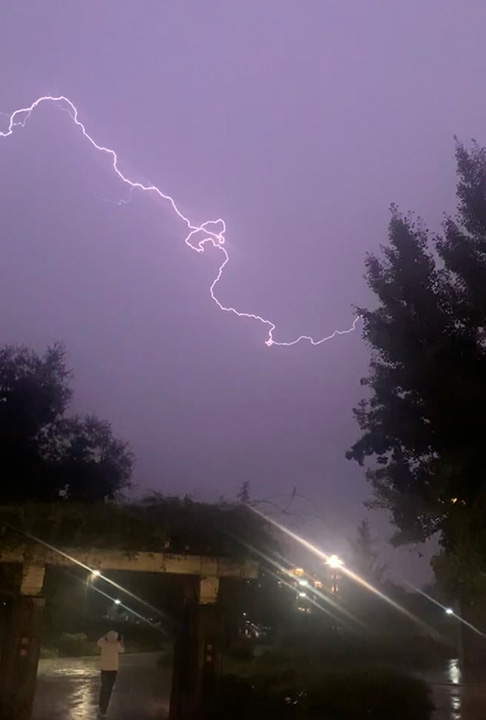Quick Summary
- Mrak, 8 other buildings lost power — most for about 3 hours
- Mrak Hall operating on a generator during repair work
- Veterinary team heads to fire, campus crew comes home
Crews are hard at work today (Sept. 20) cleaning up campus after a downpour caused flooding, internet outages and a power failure.
A transformer located in an underground utility room near Mrak Hall failed during a deluge just after 5 p.m. Monday (Sept. 19), knocking out power to nine buildings on the same high-voltage circuit, said Josh Morejohn, executive director of utilities and engineering in Facilities Management.

Two electricians restored power to all of those buildings except Mrak Hall by about 8 p.m. This morning, crews connected Mrak Hall to a generator while the transformer is replaced.
“Once the replacement transformer is installed, they will be able to turn off the generator and switch the power back over to the campus grid,” Morejohn said. “We will likely do that after 5 p.m. today as it will require another building shutdown.”
He said the cause of the failure was still being investigated, as the underground utility room is designed to withstand heavy rains.
Information and Educational Technology reported Internet outages in 31 buildings.
MU lounge is drying out
Elsewhere, rainwater rushed into the Memorial Union in what the building director, Janna Tolla, described as “some of the worst flooding I’ve seen.” Night custodial crews cleaned up most of the water and the building was open today, with the exception of a lounge area that is drying out.
A large sycamore tree was uprooted and fell on one of the cottages on La Rue Road, damaging the roof of one of the buildings near the Arboretum Headquarters.
Other debris overloaded pumps in the campus's two pedestrian and bicycle tunnels under La Rue Road, and both flooded. By this morning both were clear and scheduled to be pressure-washed.
“We’re not really designed to handle that much rain in that short of a time,” said Tyson Mantor, assistant director of the Arboretum and Public Garden.
Crews last week did what they could to prepare for the storm, clearing problematic drains and installing new oil booms where storm drains empty into the Aboretum Waterway.
“We install these as a pollution prevention measure,” said Nina Suzuki, waterway steward. “They absorb and retain oils and oil-based liquids, including lubricants and fuels, that can be washed off of roads and into the waterway with the ‘first flush’ of rain.”
Rainy introduction
Colin McCarthy came to UC Davis to study atmospheric science and found himself with a front-row seat to yesterday’s storm.
“I haven’t even taken a single class yet,” said McCarthy, who moved into the Segundo housing area last week and was bicycling around Monday night to become more familiar with the campus. He said he has always been interested in weather, tracking conditions with numerous apps on his phone and tweeting about extreme weather to an audience of almost 61,000 people. When he saw storm clouds in the distance and checked his phone, he knew it was “going to dump an incredible amount of rainfall.”
He got “drenched” on his way back, and while he waited to dry off outside, he snapped photos of lightning to post online.
“Truly a 1 in 1,000 storm this evening in Davis, California,” he wrote on Twitter. The National Oceanic and Atmospheric Administration reported 1.7 inches of rain at the campus airport, but McCarthy noted much larger totals from smaller weather stations.
VERT deployed to fire
The rain wasn’t all bad news, as the first rain to hit the region Sunday (Sept. 18) provided much-needed relief for firefighters battling the Mosquito Fire in Placer and El Dorado counties. A four-person UC Davis Fire Department crew returned to campus that night, “thanks to the rain,” Fire Chief Nate Trauernicht said. The blaze was 76,290 acres and 39% contained as of this morning, according to Cal Fire.
The crew, which had been deployed since Sept. 9, consisted of Capt. Paul Rush; engineer Derek Carthy; and firefighters Meggie Elledge and Cara Martinez
Firefighters weren’t the only ones from campus to respond to the Mosquito Fire.
Authorities called on the UC Davis Veterinary Emergency Response Team, or VERT, to conduct health and welfare checks on animals that had been evacuated. VERT director Lais Costa checked on large animals at three evacuation centers, Rancho Murieta Equestrian Center, Saureel Vineyard and Flying M Ranch, while Ashley Patterson responded to the El Dorado County Animal Shelter in Diamond Springs to examine small companion animals.
Additional VERT volunteers, including Katy Siquig, Camilla Quattrini, Nicole Kreutzfeldt, Jennifer Little, Paula Wittler, Alison Moot and Sebastian Elsenbroek, a veterinary student, rolled in next, to provide care for the animals.
Michelle Hawkins provided consultation for exotic avian animals housed at the small animal shelter. Two horses were referred to the Veterinary Medical Teaching Hospital for further examination and outpatient treatment of evacuation-related injuries. VERT remains on standby to assist as needed.
Media Resources
Cody Kitaura is a News and Media Relations Specialist in the Office of Strategic Communications, and can be reached by email or at 530-752-1932.